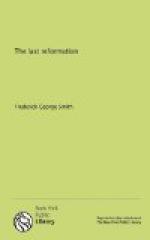[Sidenote: Fundamental causes]
What produced that transition from the humble apostolic church of the brethren to the medieval church of the impious Hildebrand, who caused monarchs to tremble on their thrones? The change resulted from two particular causes, and it is highly essential to our purpose that we understand them. One was a misconception both of the Fundamental constitution of the true church itself as designed by its Founder and of Christ’s perpetual relationship to it; and the second was the imperialistic tendencies of that age to which the first error naturally exposed the church.
It is unnecessary here to recite at length that conception of the primitive church which we have described in preceding chapters as the concrete expression of the kingdom of God. Such was the only true catholic, or universal, church. Its catholicity, however, was a moral and spiritual dominion exercised over men by the truth and Spirit of God, and was rendered visible only in the society of redeemed believers who held the truth and bore its appropriate fruits of righteousness. Being composed of the redeemed, it lovingly embraced within its membership the entire brotherhood of Christ.
[Sidenote: Two theories of catholicity]
It is not too much to say that in the age in which Christianity first appeared it was difficult for men to appreciate the conception of a purely moral and spiritual authority which was to be universal and perpetual. Another idea of catholicity soon began to take possession of men’s minds—the idea of a temporal and earthly organization of the kingdom of heaven. In this conception of the church the bond of union was not moral and spiritual—not the inevitable result of divine life and love in the individual members—but its pretended catholicity was to be secured by official, administrative, legislative, and judicial functions under a human headship and a self-perpetuating human magistracy. Such was the “mystery of iniquity,” and in its developed form historically it was “the man of sin.” The student of the New Testament can easily see that the great Founder never intended that the boundary of his church should be determined by the administrative functions of a self-perpetuating clerical corporation. But, on the other hand, the real church embraces the entire spiritual brotherhood, and out of this spiritual membership was developed by the Spirit of God the capacity and authority to teach, guide, and instruct. What a contrast these two conceptions present!
[Sidenote: The power of the keys]
Out of that worldly conception of the kingdom of God grew the Romish figment of the “power of the keys.” According to this idea, Christ constituted his ministers a sort of clerical, close corporation invested with direct authority over souls so that without their priestly mediation the kingdom of heaven is forever shut against men. The words “keys of the kingdom of heaven” (Matt. 16:19) are evidently




